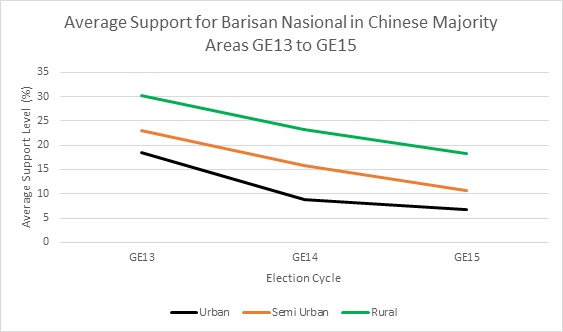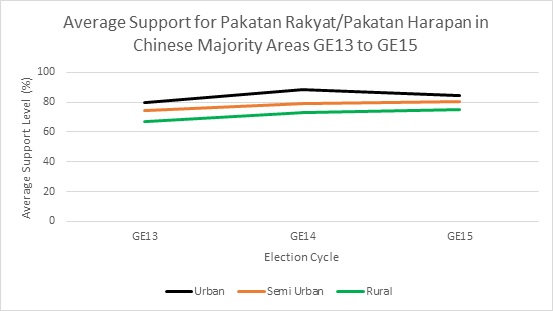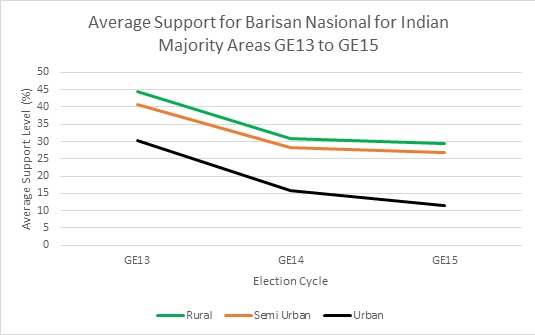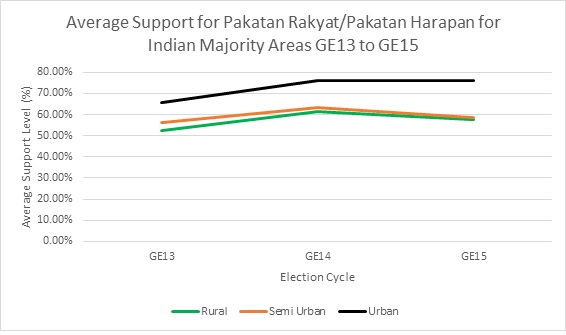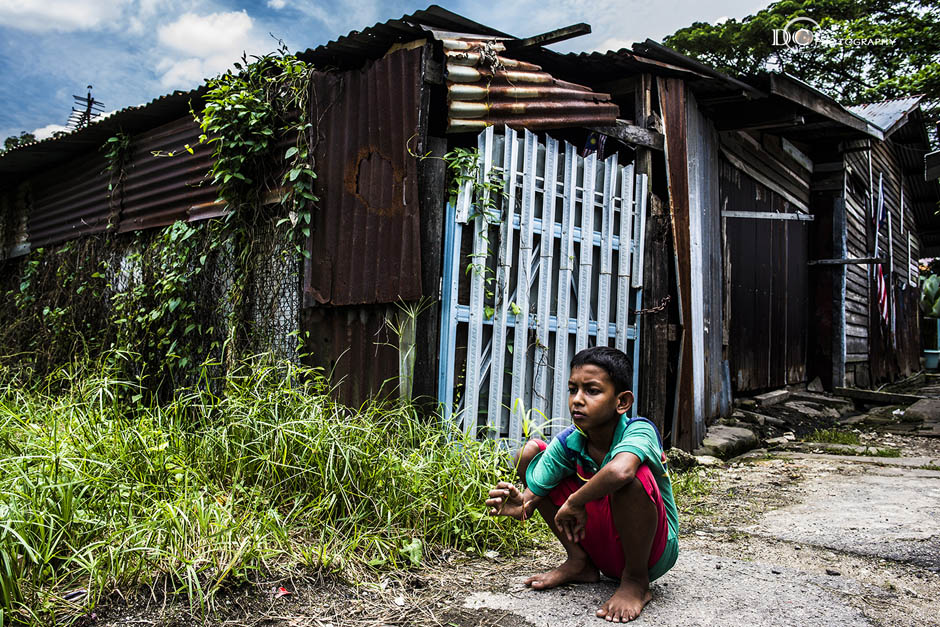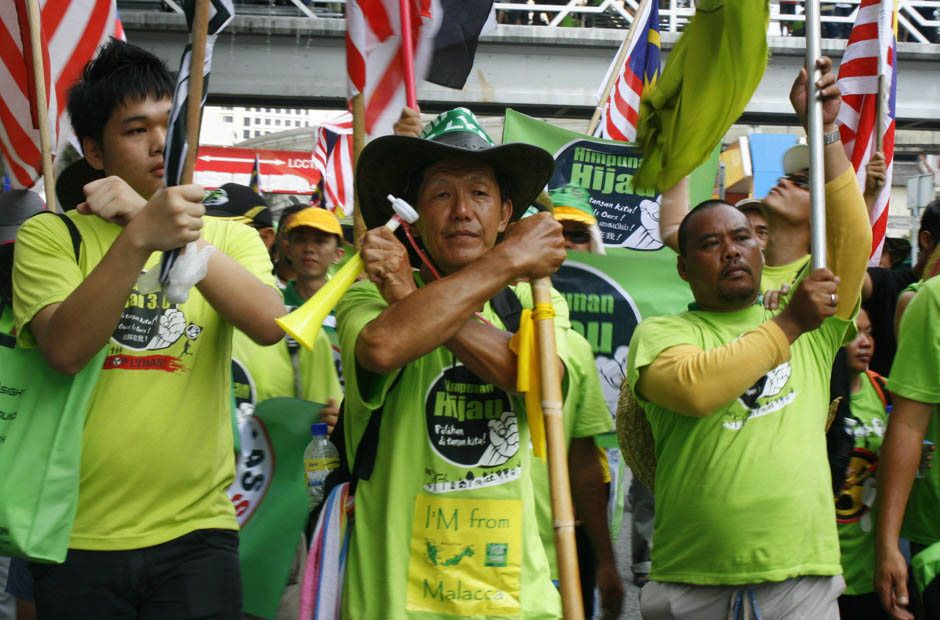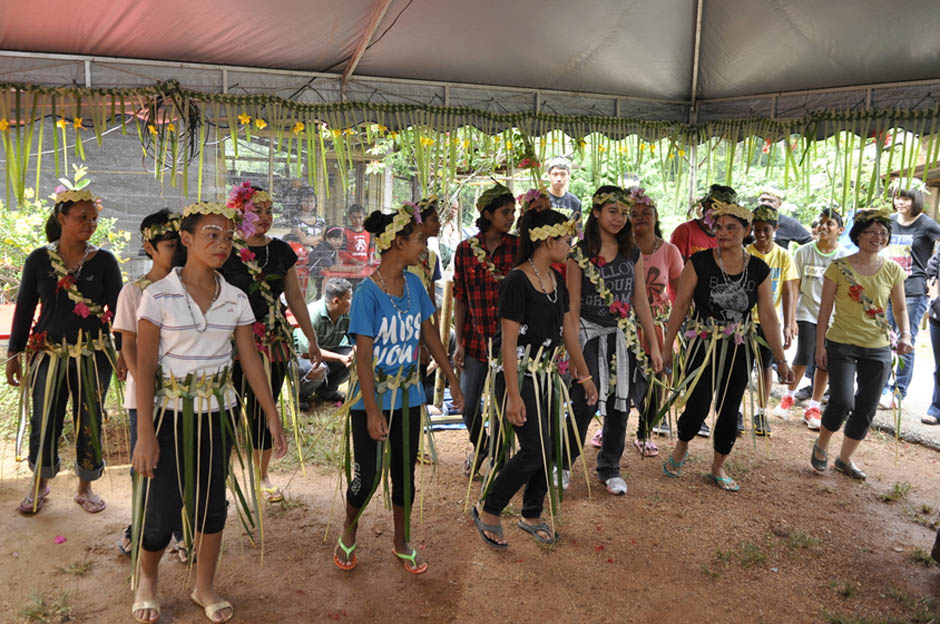| PRN 2023: SELANGOR Part 2 |
 |
 |
 |
| Wednesday, 09 August 2023 20:41 |
SELANGOR: Evolution of Voting Trends (Part 2)In the previous article, we examined the voting patterns of Selangor (GE13 to GE15) as a whole and in particular of the Malay voting community. Continuing from Part 1, we will examine shifts and variation of voting patterns in non-Malay community and early voting bloc. We will also examine the capability of non-major political forces in making headways in Selangor election scene. NON-MALAY COMMUNITY: DISSIMILARITY AND URBANIZATION IMPACT
Selangor has 13 Chinese Majority constituencies (largely Klang Valley) in GE14 and GE15. While there are no Indian majority constituencies in Selangor, Indian community commands plurality dominance in DUN Sentosa (41%). There are six mixed seats in Selangor. While some analysts and media portals would like to lump Non-Malays together, such approach is misleading and ignores the variations found in this grouped segment. In this section, we will examine voting patterns of Chinese, Indians and Orang Asli for three elections. For the Chinese community, their turnout level was the highest among communities for GE13 (85.8% on average) and GE14 (85.9%). However, they represented the lowest end (75.5%) for turnout in GE15. For the Chinese community, semi urban Chinese majority areas have higher turnout to its rural and semi urban counterparts. In GE13, semi urban Chinese majority areas registered an average turnout of 87.6% while urban Chinese majority areas registered an average turnout of 85.6%. In GE14, semi urban Chinese majority area registered a turnout of 86.3% and its urban counterpart registered turnout of 84.6%. The turnout gap between urban and semi urban areas grew further in GE15. Semi urban Chinese majority area had average turnout of 78% while its urban counterpart had average turnout 75.1%. Unlike other communities, in Chinese majority areas, Pakatan Rakyat (PR)/Pakatan Harapan (PH) has a firm grip where none of its rival is able to match the support for PR/PH. GE14 represented the zenith support level among Chinese majority areas for PH (86.42%). Despite strong changes that took place in GE15, Chinese support for PH remains bedrock solid. While Chinese community can be seen a one solid block for PR and PH, urbanization level indicates variation of such support. Referring to Figure 1, rural Chinese area (a small count) do indicate higher level of support for Barisan Nasional (BN). By GE15, BN has become an insignificant force in Chinese majority areas. From GE13 to GE15, all seats won by PR in GE13 were won again by PH in GE14 and GE15. While one must acknowledge the variations in Chinese voting preference, there is no viable political alternative for Chinese majority areas in the foreseeable future. Among all the communities in Selangor, Chinese voters have not shown substantial shifts to any other parties outside the Pakatan coalition.
Figure 1: Average Support for Barisan Nasional among Chinese Majority areas of Selangor (GE13 to GE15)
Figure 2: Average Support for Pakatan Rakyat/ Pakatan Harapan among Chinese Majority area of Selangor (GE13 to GE15)
Indian Community has shown its willingness to shift its support to certain coalitions subject to the election cycle. This means the grouping of Indian and Chinese voting preference in one group will be misleading. While Indian turnout may not be the highest among all the communities, the decline rate for turnout among Indians is the smallest. In GE13, an Indian majority area had a turnout of 82.95%. In GE14, it barely dropped to 82.62% and for GE15, it dropped to 79.02%. As matter of fact, Indian majority area turnout was second highest among all communities in GE15, after the Malay majority areas. Unlike other communities, rural Indian voter turnout is slightly less than its urban counterpart. Table below shows the comparison of Indian turnout among urbanization level.
Table 1: Voter turnout of Indian majority areas in Selangor based on Urbanization Class (GE13 to GE15)
For Indian majority areas in Selangor, there are two coalitions known to appeal to them – BN and PR/PH. Unlike the Chinese community, BN is considerable rival to PH for Indian votes. While PH dominates the Indian majority areas, the support level of Indian majority areas for PH is not stable. Indian support for PR in GE13 was 56.85% and this grew to 66.5%. However, for GE15, Indian support for PH was reversed and fell to 57.3%. While BN support remains steady for GE14 and GE15, it was noticed that in slight Indian majority areas (50 – 59.99%), Perikatan (representing more conservative forces) was able to gain 12% of the votes on average in GE15 (compared to 4.84% for previous conservative coalition led by PAS – Gagasan Sejahtera - in GE14). Urbanization informs Indian voting preferences much more strongly compared to Chinese community. A rural Indian majority area voter has shown greater support for BN compared to rural Chinese majority area voter over three election cycles.
Figure 3: Average Support for Barisan Nasional among Indian Majority areas of Selangor (GE13 to GE15)
Figure 4: Average Support for Pakatan Rakyat/ Pakatan Harapan among Indian Majority Areas of Selangor (GE13 to GE15)
For Orang Asli, which represent a presence less than 1% of Selangor electorate, there are only three to four polling districts in Selangor where their presence is a majority. They are found in DUN Kuala Kubu Baharu, Sijangkang and Banting (up to GE13). Their turnout level was slightly lower than Malay majority area turnout for GE13 (84.27%) and GE14 (83.21%). However, GE15 indicated a steep plunge of Orang Asli turnout (from 83.21 % to 76.62%). Orang Asli, once represented a fixed deposit for BN, started to part ways with BN in GE14 (from 83.17% in GE13 to 69.16% for GE14). GE15 saw Orang Asli majority area support for BN plummeted to 54.6%. PH, on other hand, manage to grow its support among Orang Asli voters in GE14 (9.6% in GE13 to 22.13%). However, PH support among Orang Asli majority areas stagnated in GE15 (23.5%). With stagnation of PH support and sharp declines for BN, PN gained 16% of the votes in Orang Asli majority areas (this was five-fold increase from Gagasan Sejahtera). Since majority (or if not all) Orang Asli voters resided in rural area, no assessment could be done on urbanization impact. In short, non-Malay voting community has shown much dissimilarity and flexibility in terms of voting preferences. Urbanization play a role in informing the variation of the same ethnic bloc. EARLY COMMUNITY: COLLAPSE OF BN FIXED DEPOSITAmong all the voting blocs, early voting (police and military) experienced one of the most drastic changes in terms of voting preferences. Once unshakeable BN fixed deposit in the heart of PR/PH held Selangor, GE15 witnessed turning of tables. For GE13 and GE14, there was no viable rival for BN in the early voting segment. In GE13, BN commanded on average of 91.78% of early vote while for GE14, it was 71.01%. In GE15, BN completely lost dominance of early voting to PN and scored on average of 44% of this voting group. PR/PH, on other hand, scored on average 6.5% of votes in GE13, then grew to 12.6% of votes in GE14 but the gains got reversed to 5% in GE15. In GE13 and GE14, BN won all the early votes for all 56 constituencies. However, GE15 resulted in tie for dominance of this voting bloc (BN and PN with each gained early votes of 28 seats). PN bagged early votes of largely police and military bases from Gombak to Bangi area. PH, on other hand, had few close shots in displacing BN for early voting in GE14 (i.e. Seri Setia, Paya Jaras). GE15 has erased PH’s ability to be an effective challenger for BN in this realm. For this coming state elections, seats to be watched for early voting will be Seri Setia, Kota Damansara and Sungai Pelek where there are significant police or military bases are found.
Impact of third forces
In our first past the post system, the electoral system incentivizes and rewards the two largest political forces in a given constituency. Hence, any split within the same voting preference group could benefit the opponent. This was demonstrated during the GE13 elections where Pakatan Rakyat’s infighting for fielding candidates in DUN Semenyih and DUN Kota Damansara. Due to disputes related to PSM candidates being fielded in two seats, the split vote bank of PR and PSM resulted BN winning two seats. In the case of DUN Semenyih, BN won 13 (Malay Majority) out of 20 polling districts and PR won remaining 7 polling districts (mixture of Malay Majority, Chinese and Mixed areas). PSM which garnered over 5500 votes had its support emanating from similar supporting areas for PR. If one were to combine PR and PSM or use GE13 Federal Results for Semenyih, PR would have won Semenyih. For Kota Damansara, PR (contested by PSM candidate) and PAS clashed and this resulted Barisan Nasional winning the seat. BN won 10 (Malay Majority areas) out 15 polling districts in Kota Damansara. PR candidate won remaining 5 (Chinese Majority areas) polling districts and PAS wielded some influence in Malay Majority areas of Kota Damansara. Due to split vote bank of then opposition in Malay Majority areas, PR (which had PSM candidate and component party of PAS) lost 7 polling districts. Using GE13 Federal Results, PR would have won Kota Damansara in 2013. In GE14, with the collapse of PR and anticipated split in opposition vote bank between PH and PAS, BN could have won many DUN seats and possibly denying two thirds majority for PH. However, the Malay voting bank was split and the electorate was keen to dislodge then Prime Minister Najib. This resulted of choosing more viable party to be an alternative to BN. PH won DUN Permatang, Bukit Melawati, Jeram and Kuang from BN even though PH won these seats with less than 50% of total votes per DUN. PAS, that has left defunct PR, could have absorbed Malay votes away from BN and this effectively handed the seats to PH. In GE15, with the Malay voting bloc in Selangor more divided, PN was able to big grounds even though they largely commanded less than 50% of the voter per DUN (exception of Selat Klang and Sijangkang). With the desertion of Malay votes from BN and PH to PN, BN was largely reduced to a third force and first the past the post system effectively exclude representation of third forces. We can see the impact of sizeable third forces in shaping the outcome of selected constituencies or throughout the state. However, we must acknowledge a third force is able to disrupt potential winner on the condition of strong voting base for the said forces (like PAS). For the coming state elections, there is no viable strong third forces.
|
| Last Updated on Wednesday, 09 August 2023 21:15 |

